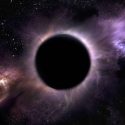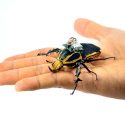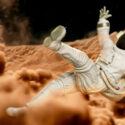It’s the oldest question on Earth. Where did we come from?
Some people may thank a creator from above, but what if the hand that created humanity wasn’t divine? What if aliens brought life to Earth?
How could a meteor carry life to our planet? Could microbes survive the cold vacuum of space? And does alien life already exist on Earth?
When you think of aliens, your imagination might run wild with movie scenes and X-Files reruns. But technically, an alien includes anything not from Earth. And that broad definition opens up some intriguing possibilities.
In 2017, astronomers detected a mysterious chunk from an exoplanet that entered our Solar System. Called Oumuamua, this interstellar object is made from nitrogen-ice, the perfect radiation shield for an organism that might be hitching a ride. After all, if this pancake-shaped rock can keep its ice formation while flying through the galaxy, then maybe life can not only exist beyond the Solar
System but also travel frozen in space. But if an object like this slammed into Earth, would the organisms survive the impact?
When our Solar System was still forming, the chunk of rock that would become Earth floated around completely unprotected from meteors and asteroids. If an object like Oumuamua had landed on Earth during that time, it could’ve brought microbes and other organisms from deep space.
This is called the panspermia theory, which states that that matter from surrounding planets or objects from deep space might have brought life to Earth. But how could we test this theory?
Researchers aboard the International Space Station found that bacteria survived on the panels outside the station. Even the extreme temperatures of space didn’t kill the bacteria. What does that prove? Well, if a spacecraft left from Mars with microbial life attached, those microbes could survive the trip to Earth.
But let’s go back to the early days of our planet. Almost 4 billion years ago, Earth went through a bombardment period. During this time, powerful meteor showers regularly rocked the surface of our world.
And several objects the size of Oumuamua, about 800 m (2,600 ft) long, crashed into the Earth. So if there were microbes deep within those meteors, they might have been cushioned from the impact. And that’s pretty impressive, considering meteors travel at speeds up to 100 km/s (62 mi/s). It would be like traveling from Manhattan to Philadelphia in less than 2 seconds!
And during that chaotic time, life began springing up all over Earth. After all, bacteria can thrive in temperatures as high as 113 °C (235 °F) or be preserved at -196 °C (-321 °F). So if those meteors had contained microbial life, it would have survived the impact and possibly planted the seeds of life. But how could we know if aliens life is already here?
Well, that evidence is harder to find. We still haven’t found life anywhere other than Earth. So thinking that life could have come from somewhere else might be a bit of a stretch. But in a system 400 light-years away, we have found the elements of life.
Using radio telescope technology, Danish researchers found glycolaldehyde, a simple sugar needed to produce ribonucleic acid or RNA. This is the macromolecule responsible for making proteins and coding genes. Glycolaldehyde is floating out there in space, waiting for a carrier to bring it to a world like ours.
But maybe it’s already here. Amino acids and sugars, the building blocks of life, come in two versions that mirror each other. We call this phenomenon chirality. And we refer to the versions as left and right.
But on Earth, all life contains left-handed shaped amino acids and right-handed shaped sugars. And that’s unusual, as scientists creating amino acids in a lab would make half of them left-handed and half right-handed. So single shapes in amino acids and sugars could be an evolutionary function. Or they could be an extraterrestrial influence.
Whether life came to Earth from outside our Solar System in a rock, or on the bottom of an alien’s foot, it’s hard to ignore this theory when we think about our place in the Universe.
Sources
- “7 Theories On The Origin Of Life”. 2016. livescience.com.
- “Origin Of Life: The Panspermia Theory | Helix Magazine”. 2021. helix.northwestern.edu.
- “Meteorites, Impacts, & Mass Extinction”. 2021. tulane.edu.
- “Lithopanspermia: How Earth May Have Seeded Life On Other Solar System Bodies – Universe Today”. 2013. Universe Today.
- “Did Life On Earth Come From Outer Space?”. Daniel Oberhaus. 2021. vice.com.



























